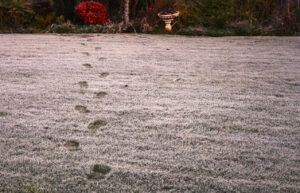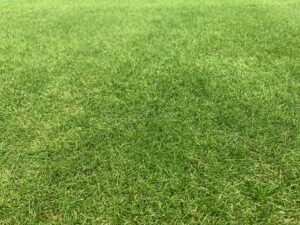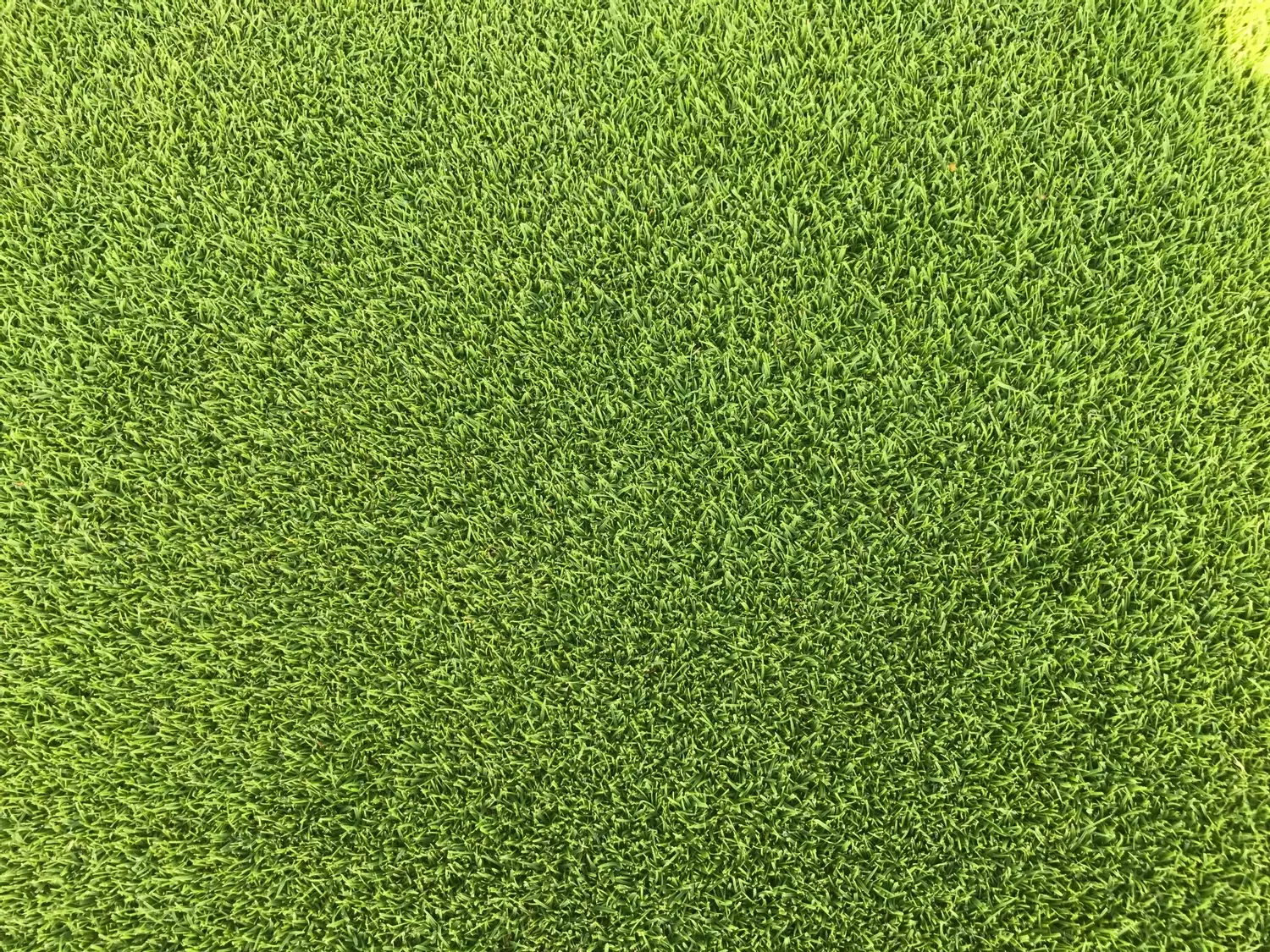What is Yellow Rattle?
Introduction:
Amidst the growing trend of cultivating vibrant and sustainable wildflower meadows in the United Kingdom, gardeners and conservation enthusiasts are turning their attention to the remarkable Yellow Rattle (Rhinanthus minor). This native annual plant plays a pivotal role in maintaining the equilibrium of wildflower ecosystems. In this article, we’ll delve into the significance of Yellow Rattle and explore how it can transform the process of establishing and maintaining UK native wildflower seed meadows.
The Role of Yellow Rattle:

Area on left has been seeded with Yellow Rattle, resulting in the grass growth being supressed.
Yellow Rattle, also known as the ‘Hay Rattle’ or ‘Cockscomb,’ is a semi-parasitic plant uniquely adapted to thrive in grassy environments. Its distinctive yellow, tube-like flowers bloom in late spring to early summer, adding a burst of colour to meadows. However, the real magic of Yellow Rattle lies beneath the surface.
This plant forms a symbiotic relationship with grasses, specifically targeting their roots through a process known as ‘hemiparasitism.’ By parasitising grasses, Yellow Rattle weakens them, preventing them from outcompeting native wildflowers. This unique mechanism encourages the development of a diverse and flourishing wildflower meadow*.
How Yellow Rattle Benefits UK Native Wildflower Seed Meadows:
- Biodiversity Enhancement: Yellow Rattle plays a crucial role in promoting biodiversity by reducing the dominance of grasses. This creates space for a diverse range of UK native wildflowers to thrive, contributing to a healthier and more balanced ecosystem.
- Seed Distribution: The rattling sound produced by the seeds inside the plant during wind movement aids in the natural distribution of seeds across the meadow. This feature facilitates the natural reseeding of UK native wildflowers.
- Sustainable Gardening Practices: Incorporating Yellow Rattle into your wildflower meadow is an eco-friendly and sustainable gardening practice. It diminishes the reliance on chemical herbicides, promoting a self-sustaining ecosystem with minimal human intervention.
- Seasonal Interest: Beyond its ecological benefits, Yellow Rattle adds seasonal interest to your meadow with its eye-catching yellow blooms. This not only enhances visual appeal but also attracts pollinators, contributing to the overall health of the ecosystem.
Conclusion:
Yellow Rattle emerges as a crucial element for those looking to enhance their UK native wildflower seed meadows. By leveraging the unique properties of this semi-parasitic plant, gardeners contribute to the conservation of native flora and create vibrant, biodiverse ecosystems in their own backyards. Embrace the power of Yellow Rattle, and witness your wildflower meadow thrive with life.
All of our perennial 100% wildflower seed mixtures and 80:20 wildflower mixtures contain Yellow Rattle seed as standard to aid the long term results of your wildflower meadow or garden.
* Westbury, Duncan & Davies, A.. (2005). Yellow Rattle – Its natural history and use in grassland diversification. British Wildlife. 17. 93-98. https://www.researchgate.net/publication/287947493_Yellow_Rattle_-_Its_natural_history_and_use_in_grassland_diversification
As winter sets in and the days grow shorter, the first widespread frosts of the season have made their appearance. But what happens if you’ve recently sown grass seed and it germinates only to be covered in frost? Does frost pose a threat to newly sown grass seed, and is there anything you can do to protect it? Let’s delve into the details.
Autumn is considered the optimal time for sowing grass seed. During this season, soil temperatures are generally high, and there is ample moisture available to facilitate successful seed germination. This stands in contrast to spring, where ideal seed-sowing conditions can quickly turn unfavourable if the weather becomes hot and dry. However, sowing grass seed in late autumn does carry the risk of encountering cold conditions. The positive news, though, is that newly sown grass seed demonstrates a considerable resilience to frost.
Your grass will be OK!
Young, recently germinated grass plants can withstand periods of air frost typically experienced in autumn. Interestingly, these young plants often maintain a slightly higher temperature than their mature counterparts. This difference is sometimes evident when areas of newly sown grass remain free of frost, contrasting with the ‘white over’ appearance of surrounding mature grass. While extended periods of deep ground frosts may negatively impact young seedlings, such conditions are unlikely in the autumn.
Nevertheless, the onset of frosts contributes to a decrease in soil temperature, slowing down the speed of germination and overall plant growth. This slowdown is a result of the inhibition of various biochemical reactions essential for growth in lower temperatures*. Additionally, cold temperatures can impact the availability of nutrients in the soil, as microbial activity responsible for breaking down organic matter and releasing nutrients slows down in colder conditions. This limitation can affect the essential nutrient supply for grass growth.
Keep off the grass!

Keep off the grass! Walking on frozen grass will damage the leaf and increase the chances of disease taking hold.
If your new grass happens to be hit by frost, it’s crucial to take one important step – stay off it! Ice crystals forming on the plant’s leaves can easily puncture the leaf when walked upon. The consequence is dark footprints that will turn yellow as the leaf dries out when the frost melts. While this damage is superficial and won’t kill the plant, it weakens it, making it more susceptible to diseases.
In summary, while frost may temporarily slow down the growth of newly sown grass and cause superficial damage, proper care and patience can help the plants recover. Avoiding walking on frosted grass and maintaining good lawn care practices will promote healthy growth once the weather conditions improve.
It’s not too late to sow.
Despite the onset of frosts, it’s not too late to sow grass seed! Perennial ryegrass will germinate in soil temperatures from 7 degrees Celsius, and red fescue from 11 degrees Celsius. Today, on the 16th of October, the soil temperature at midday registers at 10.2 degrees. Hence, although fescue may initiate growth slowly, it still falls well within the parameters for ryegrass-based mixtures such as Value Lawn Seed, Hardwearing Lawn Seed, and Multi-Purpose Lawn Seed.
*Hennessy, Deirdre & Hurtado-Uria, Cristina & Shalloo, Laurence & delaby, luc & Connor, Declan. (2013). Relationships between meteorological data and grass growth over time in the south of Ireland. https://www.researchgate.net/publication/269092361_Relationships_between_meteorological_data_and_grass_growth_over_time_in_the_south_of_Ireland
Tall Fescue – The most drought tolerant grass
In an era where water scarcity is increasingly prevalent, we often get asked what is the most drought tolerant grass? Among the contenders, tall fescue (Festuca arundinacea) has emerged as a robust champion, showcasing its remarkable adaptability and suitability to drought conditions for lawns. This hardy grass species boasts an array of characteristics that make it an ideal choice for maintaining lush and verdant lawns even in times of water scarcity.
Deep Rooting System:
One of the key reasons tall fescue excels in drought conditions is its deep and extensive root system. Unlike shallow-rooted grass species, the roots of tall fescue can penetrate deep into the soil, reaching water sources that are beyond the reach of other grasses. This feature enables tall fescue to access moisture even during extended dry periods, making it more resilient and better equipped to withstand drought stress. The deep-rooted nature of tall fescue not only aids in water uptake but also enhances its overall stability, preventing soil erosion and promoting a healthier lawn ecosystem.
Drought Resistance Mechanisms:
Tall fescue has evolved various physiological and morphological adaptations that allow it to thrive in drought conditions. One of these mechanisms involves reduced water loss through its leaves. The grass possesses narrow leaves with a waxy coating that minimises water transpiration, conserving precious moisture during hot and arid periods. Additionally, tall fescue exhibits a capacity for rapid dormancy during drought stress, temporarily ceasing its growth to conserve energy and resources until more favourable conditions return*.
Heat Tolerance:
Drought often accompanies high temperatures, and tall fescue has demonstrated impressive heat tolerance, making it well-suited for regions prone to both dry spells and scorching summers. The grass species has the ability to maintain its colour and vitality even in the face of elevated temperatures, ensuring a visually appealing lawn throughout the year. Its heat resistance further bolsters its suitability for drought conditions, as it can endure the combined stressors of water shortage and intense heat.
Versatile Growth Habits:
Tall fescue exhibits a clumping growth habit, forming tufts or bunches of grass blades rather than a spreading carpet-like growth pattern. This growth habit is advantageous in drought-prone areas as it reduces competition for water and nutrients among neighbouring grass plants. As a result, tall fescue can better allocate available resources to its individual clumps, enhancing its ability to withstand drought stress and maintain its overall health and appearance.
Low Water Requirement:
One of the most appealing aspects of tall fescue is its relatively low water requirements compared to other common turfgrass species. While it is essential to provide sufficient water to establish the grass initially, once established, tall fescue can thrive with less frequent irrigation. This characteristic is particularly appealing for homeowners and landscapers seeking to conserve water without compromising the beauty and integrity of their lawns.
Adaptability to Various Soils:
Tall fescue exhibits a broad range of soil adaptability, another factor that contributes to its suitability for drought conditions. It can grow in a variety of soil types, including clay, sandy, and loamy soils. This adaptability allows homeowners and landscapers to choose tall fescue for their lawns regardless of the soil composition, making it a versatile and accessible choice for regions with diverse soil profiles.
In conclusion, tall fescue stands out as a resilient and drought-tolerant grass species that is exceptionally well-suited to lawns in regions prone to water scarcity. Its deep root system, drought resistance mechanisms, heat tolerance, versatile growth habits, low water requirements, and adaptability to various soils collectively make it an ideal choice for maintaining lush and verdant lawns even in the face of prolonged drought conditions. By selecting tall fescue for their lawns, individuals can not only enjoy a visually appealing landscape but also contribute to water conservation efforts and promote sustainability in their communities.
Tall Fescue features in our Drought Resistent Dry Soils Grass Seed.
*Saha, Malay & Talukder, Shyamal & Azhaguvel, P. & Mukhergee, S. & Chekhovskiy, Konstantin. (2015). Deciphering Drought Tolerance in Tall Fescue [Lolium arundinaceum (Schreb.) Darbysh.]. 10.1007/978-3-319-08714-6_1. https://www.researchgate.net/publication/300756834_Deciphering_Drought_Tolerance_in_Tall_Fescue_Lolium_arundinaceum_Schreb_Darbysh
Introduction:
The Royal Liverpool Golf Club, fondly known as Hoylake, is steeped in history and renowned as one of the UK’s premier links courses. As the chosen venue for the 2023 Open Championship, meticulous preparation of the greens becomes paramount. To meet the high standards expected by players and spectators alike, a carefully curated blend of three specific grass species has been selected: Browntop Bent (Agrostis capillaris), Slender Creeping Red Fescue (Festuca rubra subsp. litoralis), and Chewings Fescue (Festuca rubra subsp. commutata). This article explores the reasoning behind choosing these grasses and their advantages in maintaining exceptional greens for the upcoming championship.

Chewing’s Fescue (Festuca rubra subsp. commutata)

Slender Creeping Red Fescue (festuca rubra litoralis)
The Unique Demands of a Championship Links Course
Royal Liverpool’s links-style golf course earns renown for its fast-running, undulating fairways and challenging bunkers. The greens, a pivotal element in the game, require specific attention. They need to be firm, true-rolling and resilient enough to endure typical foot traffic of a British links course. Optimal playing conditions for the championship hinge crucially on selecting the right grass varieties that thrive in such an environment.
Browntop Bent
Golfers hail Browntop Bentgrass, also known as Colonial Bentgrass, for its fine leaf texture and exceptional putting surface. Its capacity to generate a tightly knit, dense turf facilitates smooth ball roll and true putting lines. Moreover, Browntop Bentgrass demonstrates remarkable drought tolerance and prospers in coastal regions with salt spray, rendering it an excellent choice for the Hoylake course, situated near the Irish Sea. The grass’s stress resistance and adaptability contribute to sustaining the greens throughout the championship.

Browntop Bent (Agrostis capilaris
Slender Creeping Red Fescue
Royal Liverpool uses Slender Creeping Red Fescue in its greens. This grass complements Browntop Bentgrass with its attractive, fine-textured appearance, enhancing the overall aesthetics of the greens. Besides its ornamental appeal, this species offers excellent drought resistance and has low nutrient requirements. Its fine, dense growth habit also aids in stabilising the sandy soil typical of links courses. This helps in reducing erosion and ensuring consistent ball roll even in windy conditions.
Chewings Fescue
Completing the trio of grass species is Chewings Fescue, an adaptable cool-season grass renowned for its lush green hue and fine texture. Beyond its contribution to the visual allure of the greens, Chewings Fescue plays a pivotal role in enhancing the putting surface’s resilience. Its deep-rooted nature enables it to access water deeper in the soil, ensuring optimal water utilisation and reducing the risk of drought-induced stress during the championship. Furthermore, its moderate growth rate facilitates easier maintenance, allowing groundskeepers to achieve the desired putting speeds throughout the tournament.
Selecting the Blend
The selection of a specific grass blend for the greens at Royal Liverpool is not a haphazard decision. It demands careful consideration and expertise to create a harmonious combination that brings out the best characteristics of each species while compensating for their weaknesses. The chosen blend, featuring Browntop Bentgrass, Slender Creeping Red Fescue, and Chewings Fescue, achieves the perfect equilibrium between playability, appearance, and sustainability.
An Integrated Approach
Maintaining the greens at their prime condition requires diligent care and preparation. In the months leading up to the championship, the golf course maintenance team will follow a rigorous schedule of mowing, topdressing, and aerating the greens to encourage healthy growth and surface consistency. The team will meticulously monitor moisture levels to ensure adequate hydration without promoting disease.
Championship Standard Greens
The selection of the grasses at Royal Liverpool Golf Club reflects a commitment to providing the best possible playing conditions. This blend balances aesthetics, playability, and sustainability, creating putting surfaces that will challenge the world’s best golfers. The greens at Royal Liverpool Golf Club were elevated to new heights during this landmark event in 2023.
Browntop Bent can be found in our Pure Bent Grass Seed Mixture or as part of a blend with fescues in our Traditional Golf Greens Seed Mixture.